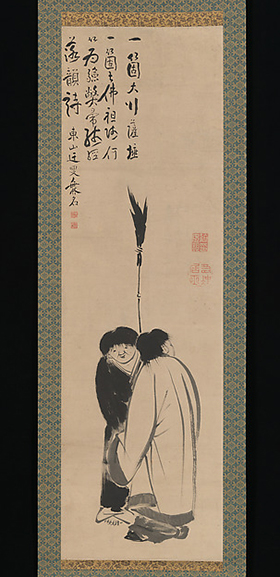Hanshan and Shide (active late 8th–early 9th century) were Chan Buddhist monks who held low-level positions at Guoqingsi, a temple on China’s sacred Mount Tiantai. Turned away from the viewer here, Hanshan (“Cold Mountain”) was a reclusive monk-poet. Shide, his constant companion, carries a broom indicating his role as the temple’s janitor. The pair of figures came to represent an iconoclastic aspect of Chan (Japanese: Zen) monastic practice and was a popular theme in Japanese painting.
In the Buddhist tradition, Hanshan and Shide were also honoured as emanations of the bodhisattvas Monju and Fugen (Sanskrit: Manjusri and Samantabhadra), representing the virtues of wisdom and compassion.
The inscription refers to this association:
One is the Bodhisattva of the Great Path,
The other the Patriarch of the Great Buddha.
What evidence is there?
A broken broom, a tattered scripture,
and unrhymed verse.
[Inscribed by] Higashiyama Usō Mumei
–Translated by Aaron Rio
Hanshan and Shide (Japanese: Kanzan and Jittoku)
Artist: Itō Jakuchū (Japanese, 1716–1800) Calligraphy attributed to Ike Taiga (Japanese, 1723–1776)
Categories: Art, Buddhism, Chan / Seon / Zen, History


😀 evidence…
A broken broom [Bodhisattva of the Great Path], a tattered scripture [Great Buddha]. #Deep
Hi there I just read your post but I’m unsure what evidence you mean. Do you mean to back up the story? Or do you mean evidence of Bhodisattvas and Janitors coming together. I just wasn’t sure what you’re asking. If it’s evidence of the story we’d first need to find out if it was a Chinese folk tale etc but if it’s evidence of Bodhisattvas we can see many in India Tibet etc. It’s a very interesting post though
Julie
I don’t he’s asking for any evidence or anything. That’s just a poem.
It says: ‘[inscribed by] Higashiyama Usō Mumei’